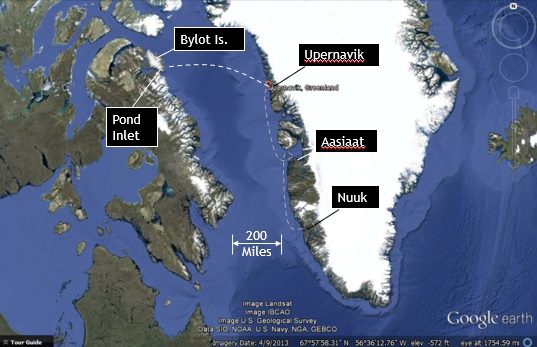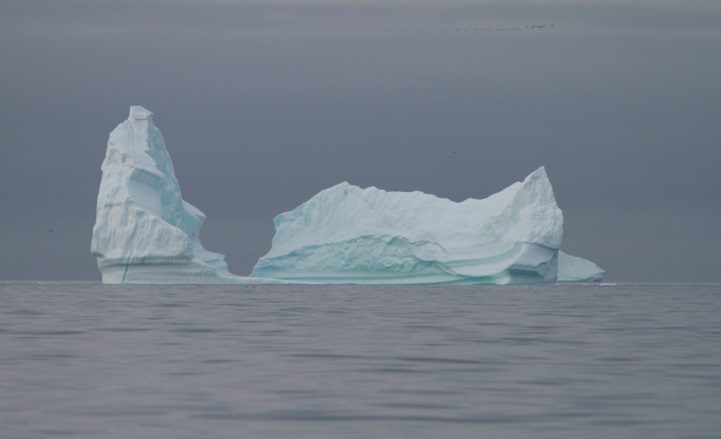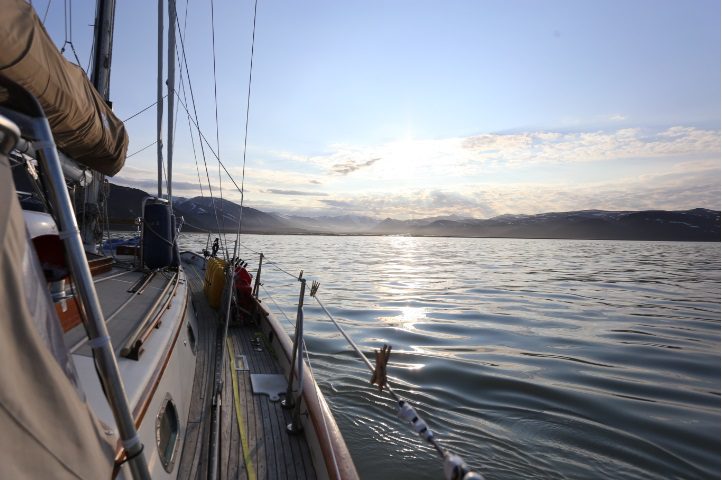Approaching Pond Inlet
Monday July 28, 2014 (72o 58’N, 76o 17’W): Approaching Pond Inlet

Early this morning, we were heading for a bay northeast of Pond Inlet, Canada. Pond Inlet is a favored entry point for the Northwest Passage, as it is a good port to resupply. As would be expected, the road here has been an ongoing shake-down cruise. In the June haste to depart on schedule, we didn’t have as much time as we’d have liked to make sure everything was in working order. It goes without saying that one would always like more time to prepare but, realistically, no matter how much the preparation, equipment will inevitable break down on a 9,000 mile voyage in a thirty year old vessel. Other than the electronics, the systems on board pre-date 2000, when Carpe Diem changed hands and became the Lillian B. Mileage has taken its toll, and new systems have their own set of issues.
For some, the feeling of accomplishment and self-sufficiency in doing one’s own repairs is part of the reward of long distance sailing. Personally, I have limited interest in fixing things. I would rather that the damn thing would just work. This is especially true of electronics, since I have absolutely no hope of being able to fix them on my own. Back in Nova Scotia, we spent half a day on the internet/phone with the manufacturer in Tennessee trying to figure out why the new Iridium e-mail system refused to talk with their server. They were not able to solve the problem before we left for Greenland. Halfway out in the Labrador Sea it magically started working … and I do mean magically.
Crew member Pete Fasoldt, being of the same generation as Neo from the Matrix, has a better understanding and patience with things electronic. Sometime in July our venerable Autohelm multi-purpose Depth, Speed and Water temperature indicator started flashing “Set Code.” A satellite phone call to the dealer in Maine was rewarded a few hours later with the response that the manufacturer was not familiar with that message and that the unit needed to be replaced. Two days later Pete announced that he had it working.
“See the four buttons on the bottom of the display?
Hit Speed and Depth together and hold them for at least 4 seconds,
Hit Reset 5 times in a row, then hit Speed
Hit Reset again 5 times followed by Speed
Repeat the above 2 more times, then
Hit Speed twice. “
The above enters the numbers 4444 into the display and then unlocks it. Peter claims it was blind luck. Whatever the case, we now have our depth, speed, and water temperature indicator back. (I still have to ask him how to reset it each time the unit is powered up.)
Things mechanical are less intimidating than those electrical. Nuuk was a good opportunity to correct several hardware issues like the leaky hose in the head, small tears in the sail where the battens had poked through, and a weld failure on the clutch pin for the mechanical autopilot. The later is now held in place by duct-tape … something I did myself. Dave, whom I suspect may actually enjoy fixing things, was able to repair the new Webasto cabin heater which was blowing fuses. While not a critical piece of equipment, it comes close.
In general, all things broken have since been fixed or duct-taped, with the notable exception of the electronic auto-pilot, “Hal,” which is the inspiration for this sharing of equipment problems. Ten years ago, Hal, was named after the computer in 2001, A Space Odyssey because of his independent thinking. Recently, he has taken to going literally in circles, making him completely useless. Having a working auto-pilot does more than just give the helmsman a break. By holding a heading, an autopilot allows the helmsman to attend to things other than steering, without having to get help. With the autopilot working, Lillian is a single handed boat. Fortunately, Hal’s counterpart, the mechanical autopilot, works well when there is a steady wind and well behaved seas, but it does not work under power. Now, when motoring, the helmsman is condemned to spending the full watch with at least one hand on the wheel.
For my early morning watch approaching Pond Inlet, there was virtually no wind. Dave had just spent his watch under the same conditions. Although it was “midnight,” there was an even light filtering through the grey overcast with a hazy visibility to the far horizon. Despite the calm, the sea had a gentle random motion, looking heavy and metallic. The water color was dull mercury with a hint of green. The horizon surrounding the boat was distance and featureless, creating a fish-eye effect. Without any reference in the distance, it becomes difficult to hold a steady course. Fortunately there was an accommodating iceberg several miles away, off the port bow, providing a point to steer by.

At our relatively slow speed, these distance bergs sometime stay with us for an entire watch. For the first two hours of the watch, I worked at keeping the iceberg aligned with the port side shroud, feeling annoyed that I had to hand steer and mentally writing this report to pass the time. With an hour to go, the featureless horizon started to hint at structure as the coastline of Canada emerged through the haze, almost imperceptibly. The annoyance of hand steering was immediately replaced by the excitement of landfall. These were the mountains of Bylot and Baffin Island. As we got closer, they looked as if the Rocky Mountains had been displaced and relocated in the middle of ocean. At 3:00 I turned my watch over to Pete. By 7:30 we were at anchor in a harbor above Cape Graham Moore, 30 miles from Pond Inlet. Dealing with Hal will have to wait until later.
